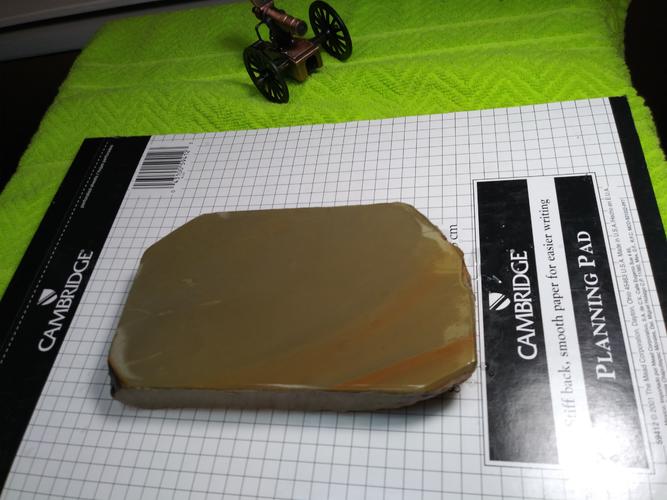Results 841 to 850 of 982
Thread: J-Nat club
-
05-06-2019, 12:16 AM #841
-
05-06-2019, 01:32 AM #842Senior Member

- Join Date
- Jan 2015
- Location
- Apex NC
- Posts
- 535
Thanked: 90
-
05-06-2019, 02:20 AM #843

My bad , my posts are often a bit laconic.
Yes Namito is a strata & the greenish colour of your stone is typical of it. As I said, my monitor shows it green. Stones that transition from Kiita to Asagi have this colour but Kiita means "yellow board". Kiita does generally refer to yellow coloured stones. They mostly occur in Namito strata.Last edited by onimaru55; 05-06-2019 at 02:42 AM.
The white gleam of swords, not the black ink of books, clears doubts and uncertainties and bleak outlooks.
-
05-07-2019, 02:03 PM #844Senior Member

- Join Date
- Jan 2015
- Location
- Apex NC
- Posts
- 535
Thanked: 90
The pics don't show the color as well as I would like and your monitor may make it more green. It sometimes looks yellow brown and other times looks yellow green to green. Depends on wet/dry and the lighting and still I go back and forth on deciding what color it is. I think it has a little bit of each and then just depend on the angle lighting and water content. I know what you mean by the Namito layer color as the one I have has a cool pattern and the one part is more of a wood brown yake color while the other is a light almost cream with a green tint to it. This does have that green tint a lot of the time and it could be a namito layer, but don't know as tomae is more common. In looking up lime green kiita I have seen a few with similar looks to this one a bit.
-
05-07-2019, 03:34 PM #845

I have one a bit on the green side with a couple orange stripes. I call it Kiita but Im not possitive that is correct.

This is wet. Its a little more green tint in person. Just a pinch more. Damn cell phone.Last edited by Gasman; 05-07-2019 at 03:36 PM.
It's just Sharpening, right?
Jerry...
-
05-07-2019, 11:44 PM #846

I must admit I don't know just how yellow a stone has to be to be called kiita. Some stones are called tamago which is Jp. for egg. Some very pale stones are called habutae referring to a type of silk cloth.
So you can have a kiita coloured stone but not all stones are "kiita" eg you can have a yellow toyota & yellow ferrari but the colour does not make them identical cars.
The orange stripes in your stone are called yake referring to sunset colors. Yake aids cutting speed like some of the other inclusions such as gomae, nashiji & renge.The white gleam of swords, not the black ink of books, clears doubts and uncertainties and bleak outlooks.
-
The Following User Says Thank You to onimaru55 For This Useful Post:
Gasman (05-08-2019)
-
05-08-2019, 12:02 AM #847

I like the orange color in this stone. Sure stands out nice. Thanks for the explaination. I will just call it Kiita until someone tells me different.
 It's just Sharpening, right?
It's just Sharpening, right?
Jerry...
-
05-08-2019, 12:20 AM #848
-
05-08-2019, 12:43 AM #849

Very cool! I wish i had an idea of the mine this came from but its not like it matters. It works. Well, so far. Im still playing with others for now. Got this one because of its looks and hoping it would make a nice prefinisher.
It's just Sharpening, right?
Jerry...
-
05-08-2019, 12:38 PM #850

Jerry, the ring pattern and the namazu (catfish!) lines are Nakayama ‘tells’, some other nearby mines had them too so these signs aren’t conclusive, but there’s a high likelihood that it came from a mine close to Nakayama if not Nakayama.
Here’s a couple with pronounced yake bands that were typical of some Nakayama stones. Usually the ones with bands like this are hard, as these are. I call the size 60 the ‘sunrise’ stone. Many jnats came from a mountain outside Kyoto, and Japan is the land of the rising sun. Look and you’ll see a mountain with the sun rising behind it. Both are stellar hones, but very hard.Last edited by Steve56; 05-08-2019 at 12:44 PM.
-
The Following User Says Thank You to Steve56 For This Useful Post:
ScoutHikerDad (05-11-2019)


 2050Likes
2050Likes LinkBack URL
LinkBack URL About LinkBacks
About LinkBacks








 Reply With Quote
Reply With Quote


